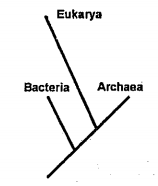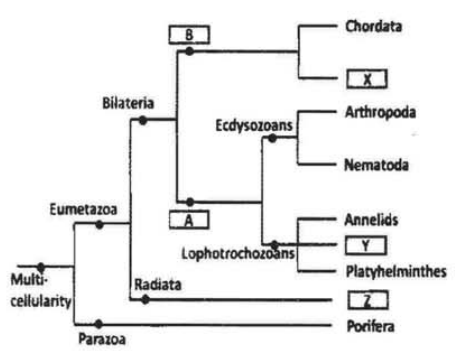 Multiple Choice Questions
Multiple Choice QuestionsEvolution of multi-gene family occurs by
only gene duplication
only unequal crossing over
random mutations
both duplication and unequal crossing over
Complex eukaryotic cells may have evolved from simpler prokaryotic cells because the complexity of organization increases the
growth rate
efficiency of energy utilization
tolerance to starvation
ability to attain larger size
The Galapagos finches were an important clue to Darwin's thinking about the origin of species. These finches are believed to have descended from a single ancestral species that colonized the Galapagos archipelago, America, over a short period of time. The Galapagos finches differ in their beak shape and size. Different species feed on seeds that vary in size and hardness.
Which of the following is the most likely explanation for these patterns?
The finches represent an example of directional trend in beak size from small to big.
Beak shapes changed in response to different seed types and these changes were inherited by subsequent generations.
The ancestral finch already had all the beak variations and different lineages formed that were specialized to eat different seed types.
The finches represent an example of adaptive radiation in which beak variation was generated by mutation followed by selection by different seed types.
In order to demonstrate that the long tails of males attracted females in a bird species experiments captured and cut the tails of 'n' number of males and monitored the number of females mated by each male. They had two types of control in the experiment.
(i) 'n' males that were not captured.
(ii) 'n' males that were captured, had their tails cut and then stitched back to attain the original size.
The males with cut tails mated with a significantly smaller number of females than both the controls. Which of the following alternative explanations is NOT ruled out by the experiment?
The stress of cutting tails affected the performance of males.
The time wasted in the capture reduced mating opportunities of males.
Females avoided any deviation from normal.
Females chose males randomly

In the phylogenetic tree above, branch-lengths are drawn proportional to the number of changes along a lineage. The following inferences were made from this tree.
(A) Bacteria are more closely related to Eukarya than to Archaea.
(B) Bacteria and Archaea are more similar to each other than either is to Eukarya.
(C) Archaea and Eukarya diverged from each other after their common ancestor diverged from bacteria.
Which of the following represents a combination of correct inference?
(A), (B) and (C)
(A) and (B) only
(B) and (C) only
(A) and (C) only
After gull nestlings hatch, the parents remove the egg-shells from the nest. This behaviour is to
clean the area
reduce infection
make more space in the nest
minimize nest detection by predators.
D.
minimize nest detection by predators.
After gull-nestlings hatch, the parents remove the egg-shells from the nest, this behaviour is to minimise the nest detection by predators.
Given below is an evolutionary tree.

Based on the above, which one of the following combinations is correct?
A - Protostome; B - Deuterostome; X - Mollusca; Y - Cnidaria; Z - Protozoa
A - Protostome; B - Deuterostome; X - Echinodermata; Y - Mollusca; Z - Cnidaria
A - Deuterostome;B - Protostome; X - Crustacea; Y - Mollusca; Z - Cnidaria
A - Deuterostoms; B - Protostome; X - Echinodermata; Y - Roundworm; Z - Ctenophora
Which of the following diseases doe not leave any paleontological evidence?
Tuberculosis
Arthritis
Rickets
Cholera
Microevolution is the term used for changes in allele frequencies that occur over time. This occurs
A. within a population at species level
B. within a community at genus level
C. due to appearance of new genes from infections.
D. due to mutation, natural selection, gene flow and genetic drift.
Which of the following combinations is NOT appropriate?
A and C
A and D
B and C
B and D
The first vertebrate animal appeared in which of the following geological ages?
A. Paleozoic era
B. Mesozoic era
C. Ordovician era
D. Cretaceous period
E. Mississippian epoch
F. Paleocene epoch
Which of the following combinations give the best answer?
A, C, and F
A and F
B, D, and E
A and C
